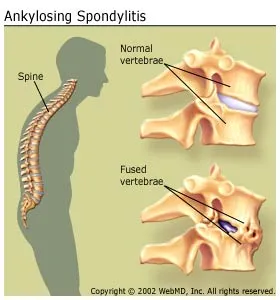Ankylosing spondylitis is a type of arthritis that affects the spine. Ankylosing spondylitis symptoms include pain and stiffness from the neck down to the lower back. The spine’s bones (vertebrae) fuse together, resulting in a rigid spine. These changes may be mild or severe, and may lead to a stooped-over posture. Early diagnosis and treatment helps control pain and stiffness and may reduce or prevent significant deformity.
Who Is Affected by Ankylosing Spondylitis?
Ankylosing spondylitis affects about 0.1% to 0.5% of the adult population. Although it can occur at any age, spondylitis most often strikes men in their teens and 20s. It is less common and generally milder in women and more common in some Native American tribes.
What Are the Symptoms of Ankylosing Spondylitis?
The most common early symptoms of ankylosing spondylitis include:
- Pain and stiffness. Constant pain and stiffness in the low back, buttocks, and hips that continue for more than three months. Spondylitis often starts around the sacroiliac joints, where the sacrum (the lowest major part of the spine) joins the ilium bone of the pelvis in the lower back region.
- Bony fusion. Ankylosing spondylitis can cause an overgrowth of the bones, which may lead to abnormal joining of bones, called “bony fusion.” Fusion affecting bones of the neck, back, or hips may impair a person’s ability to perform routine activities. Fusion of the ribs to the spine or breastbone may limit a person’s ability to expand his or her chest when taking a deep breath.
- Pain in ligaments and tendons. Spondylitis also may affect some of the ligaments and tendons that attach to bones. Tendonitis (inflammation of the tendon) may cause pain and stiffness in the area behind or beneath the heel, such as the Achilles tendon at the back of the ankle.

What Causes Ankylosing Spondylitis?
How Is Ankylosing Spondylitis Treated?
There is no cure for ankylosing spondylitis, but there are treatments that can reduce discomfort and improve function. The goals of treatment are to reduce pain and stiffness, maintain a good posture, prevent deformity, and preserve the ability to perform normal activities. When properly treated, people with ankylosing spondylitis may lead fairly normal lives. Under ideal circumstances, a team approach to treat spondylitis is recommended. Members of the treatment team typically include the patient, doctor, physical therapist, and occupational therapist. In patients with severe deformities, osteotomy and fusion can be done.
- Physical and occupational therapy. Early intervention with physical and occupational therapy is important to maintain function and minimize deformity.
- Exercise. A program of daily exercise helps reduce stiffness, strengthen the muscles around the joints and prevent or minimize the risk of disability. Deep breathing exercises may help keep the chest cage flexible. Swimming is an excellent form of exercise for people with ankylosing spondylitis.
- Medications. Certain drugs help provide relief from pain and stiffness, and allow patients to perform their exercises with minimal discomfort. Nonsteroidal anti-inflammatory drugs (NSAIDs) — such as ibuprofen, naproxen, and aspirin — are the most commonly used drugs for spondylitis treatment. In moderate to severe cases, other drugs may be added to the treatment regimen. Disease-modifying antirheumatic drugs (DMARDs), such as methotrexate (Rheumatrex), can be used when NSAIDs alone are not enough to reduce the inflammation, stiffness, and pain. In addition, relatively new drugs called biologics — adalimumab (Humira), adalimumab-atto (Amjevita), a biosimilar to Humira, certolizumab pegol (Cimzia), etanercept (Enbrel), etanercept-szzs (Erelzi), a biosimilar to Enbrel, golimumab (Simponi Aria, Simponi), infliximab (Remicade), and infliximab-dyyb (Inflectra), a biosimilar to Remicade, and secukinimab (Cosentyx)– have been FDA-approved for treating ankylosing spondylitis. Also, the antidepressant Cymbalta has been approved for chronic back pain as well. Steroid injections into the joint or tendon may be helpful in some cases.
- Surgery. Artificial joint replacement surgery may be a treatment option for some people with advanced joint disease affecting the hips or knees.

Post a comment